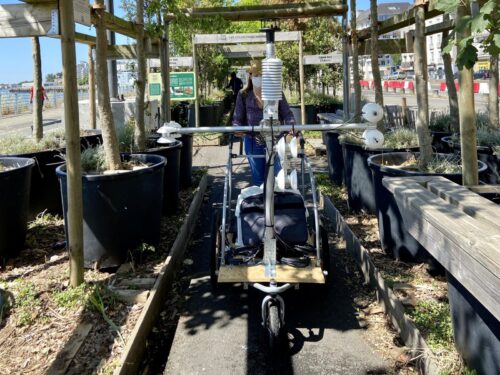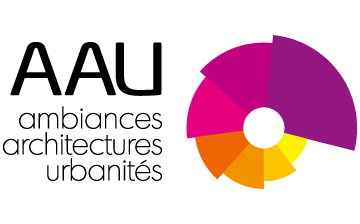COOLSCAPES – L’espace urbain climatisé : perspectives techniques, spatiales et culturelles
The cooled urban space: technological, spatial and cultural perspectives
Financement : Projet ANR 2018 Jeune Chercheur
Responsable(s) scientifique : Ignacio Requena Ruiz
Contrat de recherche terminé en juin 2023
FR
Chercheurs impliqués : Ignacio Requena Ruiz, Céline Drozd, Xenia Laffaille, Auline Rodler, Myriam Servières, Daniel Siret, Thomas Leduc et Nicolas Tixier.
Les projections climatiques actuelles prévoient, pour les régions à climat tempéré, une hausse des températures et une augmentation en fréquence des événements de chaleur extrême. Un tel scénario bousculerait les pratiques d’acclimatation des habitants de ces régions et ferait apparaître un besoin de « climatisation » des espaces publics et privés.
La climatisation est entendue ici, au-delà des systèmes d’air conditionné, comme un ensemble de techniques proposant différents degrés de conditionnement des paramètres climatiques dans l’environnement bâti. Cette climatisation prend aujourd’hui de nouvelles formes dans l’espace collectif, que nous appellerons « dispositifs spatio-climatiques » (ex. canopées rafraîchissantes, miroirs d’eau, enveloppes climatisées). Dans le contexte européen, les conséquences de ces dispositifs sur les formes matérielles, les pratiques sociales et le ressenti sensible dans l’espace collectif restent très peu connues.
COOLSCAPES a pour objectif l’étude des dispositifs spatio-climatiques dans leurs dimensions physiques, d’usages et sensibles. Une meilleure compréhension de leurs effets aiderait à mieux cibler les applications des techniques de climatisation pour l’adaptation des populations au climat futur. Trois objectifs spécifiques guident notre projet : (1) caractériser et spatialiser les paramètres climatiques d’ambiance ; (2) caractériser les usages et le ressenti des citadins ; et (3) analyser les pratiques de climatisation actuelles et identifier les axes de réflexion émergents.
Nous mènerons une recherche interdisciplinaire selon trois volets. En premier lieu, nous identifierons et analyserons des dispositifs novateurs techniquement ou spatialement. Deuxièmement, en prenant appui sur une sélection de dispositifs, nous mettrons en place une méthode de recherche basée sur l’acquisition de données in situ. D’abord, nous ferons un travail de mesures physiques géolocalisées à l’échelle du piéton afin de caractériser les paramètres thermiques d’ambiance. Un appareil de mesures mobile spécifique sera construit à cette fin. Ensuite, nous observerons les usages et les comportements, puis nous enquêterons la perception sensible des citadins à l’aide de méthodes ciblées. Ces deux étapes constitueront la base d’un travail d’expérimentation méthodologique sur le croisement des données quantitatives et qualitatives. Enfin, en troisième lieu, nous mènerons un travail de documentation de l’état des lieux et d’identification de perspectives sur la climatisation estivale des espaces collectifs. Cette étape sera faite à travers des entretiens ouverts et d’un séminaire de prospective avec un panel d’experts extérieurs.
Sur le plan scientifique, la recherche apportera des connaissances empiriques et théoriques nouvelles sur la climatisation des espaces collectifs des villes à climat tempéré. Les résultats permettront de comprendre finement le lien des techniques de climatisation avec les espaces, les usages et les ressentis. L’objet de recherche offrira un terrain d’expérimentation privilégié pour la recherche interdisciplinaire, favorisant le croisement des sciences humaines et sociales, des sciences de l’ingénieur et de l’environnement, ainsi que de l’architecture et l’aménagement urbain.
Sur le plan économique, social et culturel, la recherche sera en prise directe avec les services et collectivités locales portant le débat sur le confort d’été dans les villes. D’une part, nos contributions permettront de comprendre les effets et le potentiel des dispositifs spatio-climatiques pour les initiatives institutionnelles d’adaptation aux changements climatiques. D’autre part, nous renforcerons le transfert de connaissances vers les professionnels (concepteurs, opérateurs, fabricants). Enfin, nous constituerons, autour de l’UMR AAU, un réseau interdisciplinaire d’acteurs nationaux et internationaux sur la question de l’espace collectif climatisé.
 Mesures d’un dispositif de haute densité de végétal sur pots, installés sur une surface bitumée le 25 mai 2020.
Photo I.Requena
Mesures d’un dispositif de haute densité de végétal sur pots, installés sur une surface bitumée le 25 mai 2020.
Photo I.Requena
- Été 2020, vidéo sur la première campagne d’expérimentation des ambiances thermiques au Quai des Plantes à Nantes.
EN
The 2018 French National Research Agency (ANR) project is led by Ignacio Requena. It Involves Céline Drozd, Auline Rodler, Myriam Servières, Daniel Siret, Thomas Leduc and Nicolas Tixier in the laboratory AAU.
Within temperate zones, the current climate projections anticipate a rise in temperatures, as well as a rise in the frequency of extreme heat events. Such case would disturb the inhabitants’ acclimatisation practices in these areas, leading to the emerging of cooling systems for public and private urban spaces.
In this instance, the expression “cooling systems” is understood beyond air-conditioning systems, and is considered as a set of techniques offering different degrees for conditioning the climate parameters within the built environment. Nowadays, cooling takes new forms within urban space, which we call “spatio-climatic devices” (e.g. cooling canopies, miroirs d’eau, air-conditioned envelopes). In the European context, the consequences of these devices on the material forms, social practices and sensory perceptions in the urban space are little known.
The COOLSCAPES project’s aim is to study these spatio-climatic devices within their physical, use and sensory dimensions. A better understanding of their effects will help identifying the appropriate cooling techniques for the populations facing the future climate. Three specific objectives lead this project: (1) characterizing and spatializing the climate parameters in terms of ambiance; (2) characterizing the citizens’ uses and perceptions; and (3) analysing the current cooling practices and identifying the emerging lines of reflection.
The interdisciplinary research will revolve around three phases. Firstly, we will identify and analyse innovative devices, either on the technical or spatial scale. Secondly, relying on a selection of devices, we will set up a research methodology based on data collected in situ. We will undergo work on geo-tracked physical measurements on the pedestrian’s scale in order to characterize the thermal parameters in terms of ambiance. A specific mobile measuring device will be conceived to this end. We will then study the uses and behaviours, before examining the citizens’ sensory perception, using targeted methods. These two steps make up the base of a methodological experimentation on the cross-referencing of quantitative and qualitative data. Lastly, we will undertake a documentation work on the state of play, and an identification work regarding perspectives on cooling systems for the urban space. This last step will be possible through open interviews and a prospective seminar, involving outside experts.
On the scientific level, the study will offer innovative empirical and theoretical knowledge on cooled urban spaces in temperate cities. The results will allow for a better and finer understanding of the link between cooling techniques and spaces, uses and perceptions. The research subject will provide a prime testing ground for interdisciplinary research, stimulating the intersection of humanities and social sciences, engineering and environmental science, as well as architecture and urban planning.
On the economic, social and cultural levels, the study will be directly in touch with local services and communities regarding the debate on urban summer comfort. On the one hand, our contributions will allow us to better understand the effects and potential of spatio-climatic devices for the institutional adjustment initiatives to climate change. On the other hand, we will support the transfer of knowledge with professionals (designers, planners, operators, producers). Lastly, we will establish an interdisciplinary network around the AAU UMR, composed of national and international stakeholders, regarding cooled urban space.
